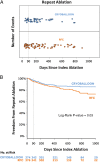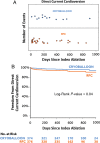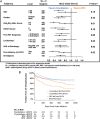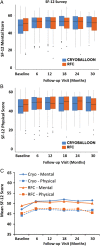Cryoballoon or radiofrequency ablation for symptomatic paroxysmal atrial fibrillation: reintervention, rehospitalization, and quality-of-life outcomes in the FIRE AND ICE trial
- PMID: 27381589
- PMCID: PMC5070448
- DOI: 10.1093/eurheartj/ehw285
Cryoballoon or radiofrequency ablation for symptomatic paroxysmal atrial fibrillation: reintervention, rehospitalization, and quality-of-life outcomes in the FIRE AND ICE trial
Abstract
Aims: The primary safety and efficacy endpoints of the randomized FIRE AND ICE trial have recently demonstrated non-inferiority of cryoballoon vs. radiofrequency current (RFC) catheter ablation in patients with drug-refractory symptomatic paroxysmal atrial fibrillation (AF). The aim of the current study was to assess outcome parameters that are important for the daily clinical management of patients using key secondary analyses. Specifically, reinterventions, rehospitalizations, and quality-of-life were examined in this randomized trial of cryoballoon vs. RFC catheter ablation.
Methods and results: Patients (374 subjects in the cryoballoon group and 376 subjects in the RFC group) were evaluated in the modified intention-to-treat cohort. After the index ablation, log-rank testing over 1000 days of follow-up demonstrated that there were statistically significant differences in favour of cryoballoon ablation with respect to repeat ablations (11.8% cryoballoon vs. 17.6% RFC; P = 0.03), direct-current cardioversions (3.2% cryoballoon vs. 6.4% RFC; P = 0.04), all-cause rehospitalizations (32.6% cryoballoon vs. 41.5% RFC; P = 0.01), and cardiovascular rehospitalizations (23.8% cryoballoon vs. 35.9% RFC; P < 0.01). There were no statistical differences between groups in the quality-of-life surveys (both mental and physical) as measured by the Short Form-12 health survey and the EuroQol five-dimension questionnaire. There was an improvement in both mental and physical quality-of-life in all patients that began at 6 months after the index ablation and was maintained throughout the 30 months of follow-up.
Conclusion: Patients treated with cryoballoon as opposed to RFC ablation had significantly fewer repeat ablations, direct-current cardioversions, all-cause rehospitalizations, and cardiovascular rehospitalizations during follow-up. Both patient groups improved in quality-of-life scores after AF ablation.
Clinical trial registration: ClinicalTrials.gov identifier: NCT01490814.
Keywords: Atrial fibrillation; Catheter ablation; Cryoballoon; Follow-up; Radiofrequency; Rehospitalization.
© The Author 2016. Published by Oxford University Press on behalf of the European Society of Cardiology.
Figures





Comment in
-
To burn or to freeze: a burning question yet to be resolved.Eur Heart J. 2016 Oct 7;37(38):2866-2868. doi: 10.1093/eurheartj/ehw344. Epub 2016 Sep 4. Eur Heart J. 2016. PMID: 27593103 No abstract available.
References
-
- Kuck KH, Brugada J, Fürnkranz A, Metzner A, Ouyang F, Chun KR, Elvan A, Arentz T, Bestehorn K, Pocock SJ, Albeneque JP, Tondo C, for the FIRE AND ICE Investigators. Cryoballoon or radiofrequency ablation for paroxysmal atrial fibrillation. N Engl J Med 2016;374:2235–2245. - PubMed
-
- Fürnkranz A, Brugada J, Albenque JP, Tondo C, Bestehorn K, Wegscheider K, Ouyang F, Kuck KH. Rationale and Design of FIRE AND ICE: a multicenter randomized trial comparing efficacy and safety of pulmonary vein isolation using a cryoballoon versus radiofrequency ablation with 3D-reconstruction. J Cardiovasc Electrophysiol 2014;25:1314–1320. - PubMed
-
- Haïssaguerre M, Jaïs P, Shah DC, Takahashi A, Hocini M, Quiniou G, Garrigue S, Le Mouroux A, Le Métayer P, Clémenty J. Spontaneous initiation of atrial fibrillation by ectopic beats originating in the pulmonary veins. N Engl J Med 1998;339:659–666. - PubMed
-
- Calkins H, Kuck KH, Cappato R, Brugada J, Camm AJ, Chen SA, Crijns HJ, Damiano RJ Jr, Davies DW, Di Marco J, Edgerton J, Ellenbogen K, Ezekowitz MD, Haines DE, Haïssaguerre M, Hindricks G, Iseka Y, Jackman W, Jalife J, Jais P, Kalman J, Keane D, Kim YH, Kirchhof P, Klein G, Kottkamp H, Kimagai K, Lindsay BD, Mansour M, Marchlinski FE, McCarthy PM, Mont JL, Morady F, Nadamanee K, Nakagawa H, Natale A, Nattel S, Packer DL, Paponne C, Prystowsky E, Raviele E, Reddy V, Ruskin JN, Shemin RJ, Tsao HM, Wilber D. 2012 HRS/EHRA/ECAS Expert Consensus Statement on Catheter and Surgical Ablation of Atrial Fibrillation: recommendations for patient selection, procedural techniques, patient management and follow-up, definitions, endpoints, and research trial design. Europace 2012;14:528–606. - PubMed
-
- Verma A, Jiang CY, Betts TR, Chen J, Deisenhofer I, Mantovan R, Macle L, Morillo CA, Haverkamp W, Weerasooriya R, Albengue JP, Nardi S, Menardi E, Novak P, Sanders P, for the STAR AF II Investigators. Approaches to catheter ablation for persistent atrial fibrillation. N Engl J Med 2015;372:1812–1822. - PubMed
Publication types
MeSH terms
Associated data
LinkOut - more resources
Full Text Sources
Other Literature Sources
Medical

